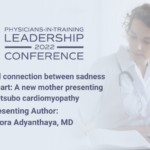Abstract | April 4, 2022
The pathological connection between sadness and a broken heart: A new mother presenting with takotsubo cardiomyopathy
Learning Objectives
- When suspected, TTC requires emergent evaluation and management as it is reversible in the majority of cases with minimal complications. Patients are known to succumb to sudden cardiac death due to cardiac arrhythmias after developing TTC. Fortunately, this patient was identified and treated with almost complete resolution of her cardiomyopathy, emphasizing early recognition and appropriate management.
Introduction: Takotsubo cardiomyopathy (TTC) characteristically affects postmenopausal females and has a reported prevalence of ~0.02% in all US hospitalizations. A state of catecholamine excess from emotional stressors in the presence of a known psychiatric illness is hypothesized as proposed underlying pathophysiology. Rarely, pregnant women exposed to emotional stressors in the peripartum period can develop TTC, and we present one such circumstance in this report.
Case Presentation: A 36-year-old woman presented with a sudden onset chest pain 6 days postpartum after an uncomplicated cesarean section. En route to the ER, she became unresponsive and was reported to have convulsive activity followed by a cardiac arrest with pulseless ventricular tachycardia. ACLS protocol was initiated, the patient got intubated with the return of spontaneous circulation in 15 minutes. Her medical history included hypothyroidism, paroxysmal atrial fibrillation(AF) status postablation and recently diagnosed depression on citalopram.
She was afebrile with a pulse of 146, BP 130/56, saturating 100% on mechanical ventilation. She was anemic with hemoglobin of 8.8, non-anion gap metabolic acidosis with pH 6.92, troponin 0.139, which trended up to 13.5 in 5 hours. ECG showed AF with RVR. CT with angiogram ruled out pulmonary embolism. Heparin drip was initiated for suspected acute coronary syndrome along with amiodarone drip for AF.
Diagnosis: She underwent cardiac catheterization, which showed normal coronary arteries with ejection fraction(EF) of 25%, severe hypokinesia of the mid to distal left ventricle and apical ballooning consistent with TTC. Transthoracic echocardiogram (TTE) demonstrated similar findings.
Treatment: In the ICU, she was continued on heparin and started on low dose sacubitril/valsartan, metoprolol and aspirin. She improved clinically and was extubated within 24 hours. The patient had retrograde amnesia upon awakening, with her last recollection being childbirth and reported feeling increasingly depressed peripartum. She recovered from the acute illness in 1 week and was discharged home with a LifeVest and appropriate medical management. Follow up TTE in 2 months revealed an EF of 50% and no regional wall motion abnormalities.

